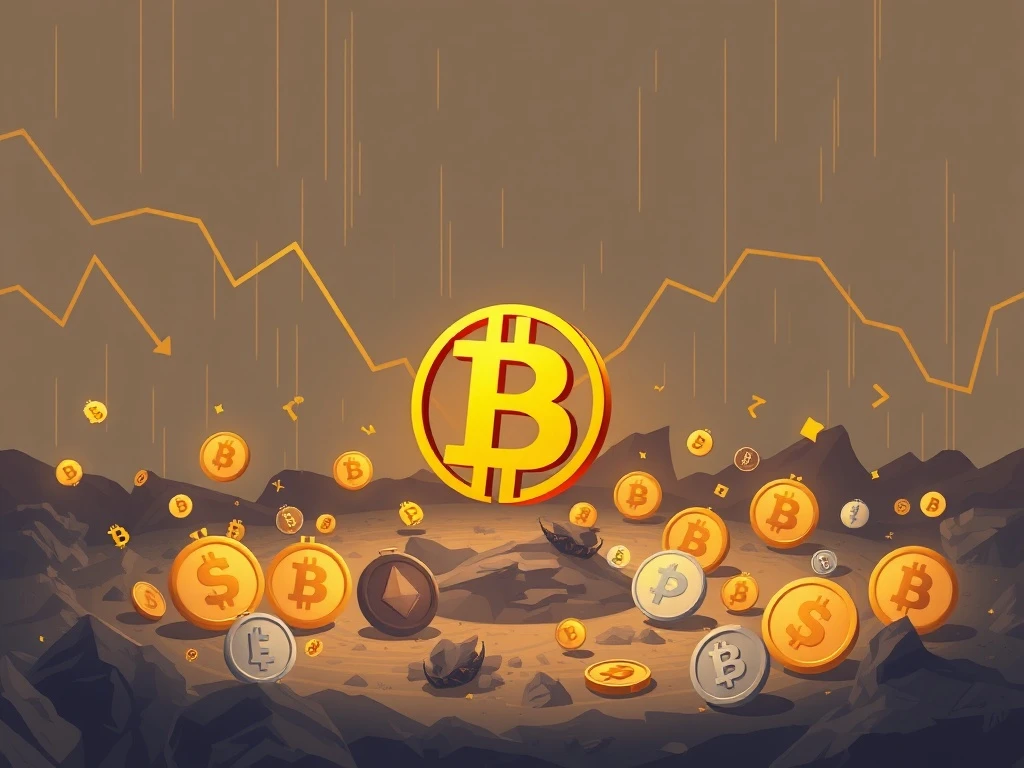Ethereum Weakness: Urgent Crisis as Altcoins Plunge Over 40% While Bitcoin Holds Steady

The cryptocurrency market is currently navigating a period of significant turbulence, presenting a stark contrast between the resilience of Bitcoin and the struggles of many smaller cryptocurrencies. While Bitcoin maintains remarkable Bitcoin stability near the $118,000 mark, the broader altcoin sector has faced a severe Altcoin plunge, with some tokens experiencing declines exceeding 40%. This divergence highlights a critical phase for investors, as heightened selling pressures and shifting sentiment underscore the inherent volatility of the digital asset space. Understanding these dynamics is crucial for anyone looking to navigate the current crypto market uncertainty.
Is Ethereum Weakness Driving the Altcoin Plunge?
Much of the current market unease can be attributed to the ongoing Ethereum weakness. The second-largest cryptocurrency recently dipped below the $3,700 level, a move that triggered a significant $3 million liquidation for a major trader holding leveraged positions. This event serves as a clear indicator of the broader risks associated with the current market conditions and how Ethereum’s performance can ripple across the entire ecosystem.
The impact of Ethereum’s struggles is not confined to ETH itself. Key altcoins, often influenced by Ethereum’s price movements and ecosystem health, are feeling the pressure:
- BNB: After reaching a 230-day high of $810, BNB now faces significant risk of retracing. If Ethereum weakens further, BNB could test support levels around $745, with increased selling activity potentially pushing it towards $722–$686.
- AVAX: This token remains stuck below $27, with its critical support at $22.5–$22 under threat. Broader macroeconomic factors, including legal and political developments from the Department of Justice, are adding to market jitters, potentially driving AVAX towards $19.7.
- Solana (SOL): Solana’s recent failure to establish $203 as a stable support level has exposed its vulnerabilities. Continued instability in Ethereum could see SOL decline further to $189–$165.
The Scale of the Altcoin Plunge: What’s Happening?
The severity of the Altcoin plunge is evident across various tokens, extending beyond just the major players. Dogecoin, for instance, saw an 8% fall to $0.243. While analysts are watching for a potential rebound above $0.4 as a signal for broader altcoin recovery, a breakdown below $0.18 could accelerate its slide to $0.145 by early August.
A particularly stark example of the current market fragility is the performance of Pump.fun’s PUMP token. In its first trading week, PUMP plunged over 40%, primarily driven by heavy presale selling. Blockchain analytics reveal that 31.6% of presale buyers liquidated their holdings on decentralized exchanges, while 53% moved tokens to centralized platforms, indicating strong downward pressure. Despite these significant losses, a notable 75% of traders remain bullish, betting on a rebound, supported by $19.81 million in buybacks.
How Does Bitcoin Maintain its Stability Amidst the Chaos?
In sharp contrast to the widespread Altcoin plunge, Bitcoin has demonstrated remarkable Bitcoin stability. Maintaining its position near $118,000, Bitcoin’s resilience can be attributed to its role as a perceived safe haven asset in times of heightened market volatility. Institutional investors, in particular, have been observed shifting capital away from riskier altcoins and into Bitcoin, seeking refuge from the current market storm. This trend underscores a broader risk-averse strategy adopted by major players, reinforcing Bitcoin’s position as the dominant cryptocurrency.
Navigating Crypto Market Uncertainty: What Factors Are At Play?
The current environment of crypto market uncertainty is compounded by a mix of interconnected risks and broader macroeconomic factors. Beyond the internal dynamics of the crypto space, external pressures contribute to investor jitters. Legal and political developments, such as those linked to the Department of Justice, can create significant market apprehension, influencing investor decisions and exacerbating price movements across the board.
A recent study highlighted how volatility in one asset can create a ripple effect throughout the entire crypto ecosystem, emphasizing the need for careful risk management. While some analysts caution about the structural challenges facing altcoins, others point to potential entry points for swing traders, particularly in tokens that have seen steep declines like AAVE and PIVX. These differing perspectives reflect the complex and often contradictory signals within the market.
Whales, or large holders, are demonstrating mixed strategies: cashing in profits in some tokens while enduring losses in others, betting on eventual rebounds. Meanwhile, traditional industrial demand indicators, such as U.S. EIA crude runs hitting 16.9 million bpd, offer macroeconomic optimism, though the crypto sector often remains insulated from such trends, reacting more to its internal narratives and regulatory news.
Is an Altcoin Recovery on the Horizon?
Despite the current challenges, the question of an Altcoin recovery remains a key point of discussion. The path to a rebound is complex and hinges on several critical indicators. For one, the stabilization of Ethereum above key support levels will be crucial. If Ethereum can find its footing and reverse its downward trend, it could provide the necessary catalyst for broader market sentiment improvement.
Similarly, the efforts by projects like Pump.fun to stabilize their tokens and manage selling pressure will be closely watched. While 75% of PUMP traders remain bullish despite recent losses, their conviction will be tested by sustained selling pressure. For now, the market remains in a delicate balancing act between caution and optimism. Traders looking for opportunities should exercise extreme diligence, focusing on strong fundamentals and clear technical signals before making moves.
Conclusion: A Market at a Crossroads
The cryptocurrency market is undoubtedly at a pivotal juncture. The stark divergence between Bitcoin’s steady performance and the significant Altcoin plunge, largely influenced by Ethereum weakness, creates a challenging landscape. While crypto market uncertainty persists due to internal and external factors, the potential for an Altcoin recovery remains a topic of keen interest. Investors and traders must remain vigilant, adapting their strategies to the evolving market conditions and focusing on robust risk management. The coming weeks will likely reveal whether altcoins can find their footing or if the current pressures will lead to further corrections.
Frequently Asked Questions (FAQs)
Q1: Why are altcoins experiencing such a significant plunge while Bitcoin remains stable?
The primary reason for the altcoin plunge is often attributed to Ethereum weakness, as ETH’s price movements significantly influence the broader altcoin market. When Ethereum struggles, it creates a ripple effect. Additionally, heightened selling pressures, shifting investor sentiment, and macroeconomic factors like regulatory concerns contribute to the altcoin downturn. Bitcoin, on the other hand, is often seen as a safe haven, attracting capital from institutional investors during uncertain times, thus maintaining its Bitcoin stability.
Q2: What are the key price levels to watch for Ethereum (ETH) and other major altcoins?
For Ethereum, a drop below $3,700 triggered significant liquidations, making this a critical resistance level. For BNB, watch for retracements to $745 or lower ($722–$686). AVAX needs to hold $22.5–$22 to avoid a potential drop to $19.7. Solana’s failure to hold $203 could lead to declines towards $189–$165. Dogecoin needs to rebound above $0.4 for a positive signal, but a breakdown below $0.18 could accelerate its slide.
Q3: Is now a good time to invest in altcoins, or should I wait for an Altcoin recovery?
The current market presents significant crypto market uncertainty. While some analysts see the steep declines as potential entry points for speculative swing traders, the path to a sustained Altcoin recovery is still clouded by persistent selling pressure and Ethereum’s performance. It’s crucial to exercise extreme diligence, conduct thorough research, and consider robust risk management strategies before investing. Many institutional investors are currently shifting to Bitcoin as a safer asset.
Q4: How do external factors, like regulatory news, affect the crypto market?
External factors, such as legal and political developments linked to government bodies like the Department of Justice, can significantly exacerbate market jitters. Such news creates uncertainty, leading investors to reduce their exposure to riskier assets like altcoins. This contributes to increased volatility and selling pressure across the market, highlighting the interconnectedness of the crypto ecosystem with broader regulatory landscapes.
Q5: What role do ‘whales’ play in the current market dynamics?
Whales, or large holders of cryptocurrency, play a significant role in market dynamics. In the current environment, they are demonstrating mixed strategies. Some are cashing in profits from certain tokens, while others are enduring losses in different assets, betting on eventual rebounds. Their movements can influence market sentiment and liquidity, contributing to the volatility and overall direction of the market as they strategically rebalance their portfolios.









